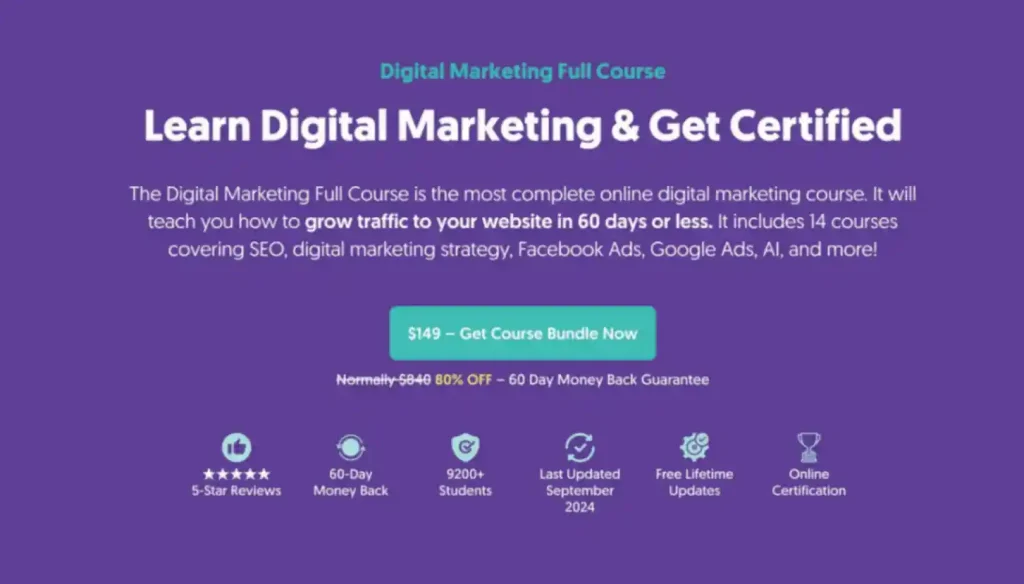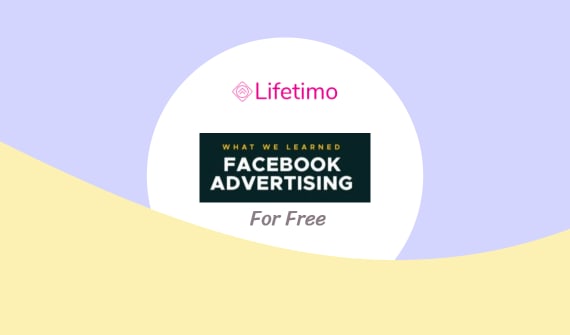Facebook advertising can be tricky and complex. Many courses promise results but fall short.
This post dives into a valuable resource: the Facebook Advertising Lifetime Free Course. We explored the course to understand its true worth. From beginner tips to advanced strategies, this course offers insights for all levels. It claims to cover everything about Facebook ads at no cost.
So, what did we learn? Is it as good as it sounds? This blog post will share our findings. Dive in to see if this course is the right fit for you. Learn how it can help you navigate the world of Facebook advertising effectively.
Introduction To Facebook Advertising

Facebook Advertising has become a crucial tool for businesses. It helps connect with potential customers. Learning Facebook advertising can greatly benefit your business. Our Lifetime Free Course offers valuable insights into this powerful platform.
Importance Of Facebook Ads
Facebook ads allow businesses to reach a large audience. With over 2.8 billion users, Facebook is a massive platform. Advertising on Facebook can boost brand awareness. It is a cost-effective method to increase sales. Targeting options help reach the right audience. You can specify age, location, interests, and more. This ensures your ads are seen by those interested in your product.
Course Objectives
Our course aims to make you proficient in Facebook advertising. You will learn how to create effective ad campaigns. Understanding audience targeting is a key objective. You will also learn to set budgets and measure ad performance. The course covers different ad formats and their uses. By the end, you will be able to optimize ads for better results.
Setting Up Your Facebook Ad Account

Setting up your Facebook ad account is the first step to start advertising. This essential process ensures your ads reach the right audience efficiently. Let’s break down the steps to get your ad account up and running smoothly.
Creating An Ad Account
First, log into your Facebook account. Go to the Ads Manager. Click on “Create Account.” Follow the prompts to enter your business details. Include your business name, address, and payment info. Review all the information carefully. Click “Submit” to complete the setup.
Navigating The Ads Manager
Once your ad account is set up, familiarize yourself with the Ads Manager. The dashboard is your control center for all ad activities. On the left side, you will see several tabs. These include Campaigns, Ad Sets, and Ads. Each tab helps you manage different stages of your advertising.
In the center, you will find a summary of your campaigns. You can monitor performance, tweak settings, and view results. The right side contains tools and resources. Use these to optimize your ads and improve targeting. Spend time exploring each section to get comfortable.
Defining Your Target Audience
Defining Your Target Audience is crucial for successful Facebook advertising. Understanding your audience means your ads reach the right people. This helps in better engagement and higher conversion rates. Let’s explore some effective methods to define your target audience.
Using Facebook Audience Insights
Facebook Audience Insights is a powerful tool. It helps you understand your audience better. You can learn about:
- Demographics: Age, gender, relationship status.
- Interests: Hobbies, pages liked, topics followed.
- Location: Where your audience lives, travels.
- Behavior: Purchase habits, device usage.
Using these insights, you can create ads that resonate with your audience. This increases the chances of engagement. Always analyze data and adjust your strategy. This helps in refining your target audience.
Custom And Lookalike Audiences
Custom Audiences allow you to target users based on their past interactions with your business. You can create a Custom Audience using:
- Customer lists: Email addresses, phone numbers.
- Website traffic: Users who visited specific pages.
- App activity: Users who engaged with your app.
- Engagement: Users who interacted with your content on Facebook.
Lookalike Audiences help you find new users similar to your existing customers. Facebook uses data from your Custom Audiences to find similar users. This expands your reach to potential new customers who are likely interested in your products or services.
Both Custom and Lookalike Audiences help in targeting ads more effectively. They ensure your ads reach people with higher chances of conversion. This improves the overall performance of your ad campaigns.
Creating Effective Ad Campaigns
Creating effective ad campaigns on Facebook can be a game-changer for your business. By following a structured approach, you can reach your target audience and achieve your marketing goals. In this section, we will explore how to choose campaign objectives and craft compelling ad copy.
Choosing Campaign Objectives
The first step in creating an effective ad campaign is selecting the right objective. Facebook offers various objectives to meet different business goals. These include brand awareness, traffic, engagement, app installs, video views, lead generation, and conversions.
Identify your business goals. Then, match them with the appropriate campaign objective. For example, if you want to increase website visits, choose the traffic objective. If you aim to boost sales, go for conversions. This alignment ensures your ads are optimized for your specific goals.
Crafting Compelling Ad Copy
Effective ad copy grabs attention and encourages action. Start with a strong headline. It should be clear and concise. Use simple language that resonates with your audience.
Next, focus on the main message. Highlight the benefits of your product or service. Use persuasive language, but keep it straightforward. Avoid jargon or complex words. Make sure the text is easy to read and understand.
Include a clear call-to-action (CTA). Tell users what you want them to do, such as “Learn More,” “Sign Up,” or “Shop Now.” A strong CTA can significantly increase engagement and conversions.
Designing Visually Appealing Ads
Creating visually appealing ads is crucial for successful Facebook advertising. Attractive ads grab attention, drive engagement, and boost conversions. Learn how to design compelling ads in our free Facebook Advertising Lifetime Course.
Selecting Images And Videos
Choosing the right images and videos is essential. High-quality visuals capture attention and convey your message quickly.
- Use bright and clear images.
- Ensure images relate to your product or service.
- Opt for videos with a strong opening scene.
Consider these points to select the best visuals:
- Relevance: Ensure images and videos match your ad’s message.
- Quality: Use high-resolution images and professionally shot videos.
- Emotion: Choose visuals that evoke an emotional response.
Ad Format Options
Facebook offers various ad formats. Each format serves a different purpose and audience.
| Ad Format | Description |
|---|---|
| Image Ads | Simple yet effective ads with a single image. |
| Video Ads | Engaging ads that use video to tell a story. |
| Carousel Ads | Ads showcasing multiple images or videos in one ad. |
| Slideshow Ads | Lightweight video ads using multiple images. |
Each format has unique strengths. Choose the format that aligns with your goals. For instance, use carousel ads to showcase different products. Use video ads to tell a compelling story.
Setting Budgets And Bidding Strategies
Understanding budgets and bidding strategies is key to effective Facebook advertising. These elements control how your ads spend money and how they compete. Let’s dive into the two main aspects: Daily vs. Lifetime Budgets and Manual vs. Automatic Bidding.
Daily Vs. Lifetime Budgets
Choosing between a daily budget and a lifetime budget depends on your campaign goals. A daily budget sets a specific amount to spend each day. This ensures consistent spending and helps manage your cash flow.
A lifetime budget sets a total amount to spend over the entire campaign duration. Facebook optimizes spending to get the best results within your set timeframe. This option is great for time-bound promotions or when you want more control over the overall spend.
| Daily Budget | Lifetime Budget |
|---|---|
| Spends a set amount each day | Spends a set amount over the entire campaign |
| Good for consistent daily reach | Good for time-bound promotions |
| Easier to manage daily cash flow | More control over total spend |
Manual Vs. Automatic Bidding
Choosing between manual bidding and automatic bidding also impacts your campaign. With manual bidding, you set your own bid for each action. This offers more control but requires more attention and expertise.
Automatic bidding lets Facebook set the bid to get the best results. It’s easier and saves time, but you have less control over each bid.
- Manual Bidding: Control over each bid
- Automatic Bidding: Facebook optimizes bids
Manual bidding is ideal for seasoned advertisers with clear cost goals. Automatic bidding suits beginners or those with less time for management.
Analyzing Ad Performance
Understanding how to analyze ad performance is crucial for any Facebook advertising campaign. It helps you see what’s working, what needs improvement, and how you can optimize your ads for better results. In this section, we’ll explore key metrics to track and how to use Facebook Analytics effectively.
Key Metrics To Track
Monitoring the right metrics ensures your ads meet their objectives. Here are some essential metrics to consider:
- Click-Through Rate (CTR): Measures the percentage of people who clicked on your ad.
- Conversion Rate: Shows the percentage of clicks that led to a desired action.
- Cost Per Click (CPC): The average cost you pay for each click on your ad.
- Return on Ad Spend (ROAS): Calculates the revenue generated for every dollar spent on ads.
- Impressions: Counts how many times your ad was shown to users.
- Engagement Rate: Measures interactions like likes, shares, and comments on your ad.
Using Facebook Analytics
Facebook Analytics is a powerful tool that provides detailed insights into your ad performance. Here’s how you can make the most of it:
- Access Your Dashboard: Navigate to the Facebook Analytics section in your Ads Manager. Here, you can view an overview of your ad campaigns.
- Customize Reports: Tailor your reports to focus on the metrics that matter most to your business. You can filter data by date range, audience demographics, and more.
- Track User Behavior: Monitor how users interact with your ads and website. This can help you understand their journey and optimize your ad strategy.
- Set Goals: Define clear objectives for your ad campaigns. Use Facebook Analytics to track your progress and make data-driven decisions.
- Analyze Competitors: Compare your ad performance with industry benchmarks. Identify areas where you can improve and stay ahead of the competition.
Using these insights, you can refine your ad campaigns for better engagement and higher conversions.
Optimizing And Scaling Campaigns
Optimizing and scaling campaigns is crucial for successful Facebook advertising. It ensures that your ads reach the right audience and achieve the desired results. In this section, we will discuss A/B testing strategies and how to scale successful ads effectively.
A/b Testing Strategies
A/B testing, also known as split testing, is a method to compare two versions of an ad. This helps determine which version performs better. To start, create two variations of your ad with one key difference. This could be the image, headline, or call-to-action.
Run both ads simultaneously to the same audience. Monitor their performance metrics closely. Look at click-through rates, conversion rates, and engagement. After collecting enough data, identify the better-performing ad. Use these insights to refine your ads and improve future campaigns.
Scaling Successful Ads
Scaling successful ads means increasing their reach without losing performance. Start by increasing the budget of your best-performing ads gradually. This helps maintain their efficiency and effectiveness. Avoid sudden large increases as this can disrupt the performance.
Consider expanding your target audience while scaling. Use lookalike audiences to reach people similar to your existing customers. Monitor the performance closely as you scale. Adjust your strategy based on the data to ensure continued success.
Common Mistakes And How To Avoid Them
Understanding Facebook advertising can be challenging. Many users make common mistakes that hinder their success. Here, we discuss these mistakes and provide tips to avoid them. Let’s dive into the most frequent errors and how to steer clear of them.
Targeting Errors
Targeting the right audience is crucial. Many advertisers either target too broadly or too narrowly. Both can lead to poor ad performance.
Too broad: Ads may reach people with no interest in your product. This wastes money. To avoid this, narrow down your audience by using specific interests, behaviors, and demographics.
Too narrow: Ads may miss potential customers. This limits your reach. To prevent this, avoid excessive filters. Aim for a balance.
Use Facebook’s Audience Insights tool. It helps you understand your audience better. This ensures your ads reach the right people.
Budgeting Pitfalls
Budgeting mistakes can drain your funds. They can also lead to underperformance. Here are common pitfalls and how to avoid them:
- Overspending: Setting a high budget without testing can waste money. Start with a small budget. Monitor the results and adjust.
- Underspending: A low budget may not give ads enough exposure. Ensure your budget matches your campaign goals.
- Ignoring the bidding strategy: Facebook offers various bidding options. Choose the one that aligns with your objectives. Test different strategies to find the best fit.
Regularly review your ad spend and adjust as needed. This keeps your campaign on track.
| Common Budgeting Mistakes | How to Avoid Them |
|---|---|
| Overspending | Start small, monitor, and adjust |
| Underspending | Match budget to campaign goals |
| Ignoring Bidding Strategy | Choose and test different strategies |
Effective budgeting can make or break your campaign. Stay vigilant and proactive in your approach.
Advanced Facebook Advertising Techniques
Learning advanced Facebook advertising techniques can greatly enhance your marketing efforts. This section covers two powerful methods: Retargeting Strategies and Using Facebook Pixel. These techniques help increase conversion rates and optimize ad spend.
Retargeting Strategies
Retargeting is a crucial aspect of Facebook advertising. It involves showing ads to users who have previously interacted with your website or app. This strategy keeps your brand in front of potential customers, encouraging them to convert.
Key Benefits of Retargeting:
- Increases brand recall
- Boosts conversion rates
- Optimizes ad spend
To create an effective retargeting campaign, segment your audience based on their behavior. For example:
- Users who visited a product page but didn’t purchase
- Users who added items to their cart but didn’t check out
- Users who completed a purchase
Tailor your ads to each segment. For users who visited a product page, show ads highlighting the product’s benefits. For users who added items to their cart, offer a discount to encourage them to complete the purchase.
Using Facebook Pixel
The Facebook Pixel is a piece of code you add to your website. It tracks user interactions and provides valuable data for optimizing your ads.
Steps to Set Up Facebook Pixel:
- Create a Facebook Pixel in your Ads Manager
- Copy the Pixel code provided
- Paste the code into the header of your website
Once the Pixel is set up, you can track various events, such as:
- Page views
- Purchases
- Sign-ups
Analyzing this data helps you understand user behavior and optimize your campaigns. You can create Custom Audiences based on Pixel data and target users more effectively.
In summary, mastering advanced techniques like Retargeting Strategies and using Facebook Pixel can significantly improve your Facebook advertising results.
Conclusion And Next Steps
This course taught us the basics of Facebook advertising. We learned about creating effective ad campaigns and targeting the right audience. Next steps involve applying these skills to real-world advertising projects.
As we reach the end of this comprehensive Facebook Advertising Lifetime Free Course, it’s essential to consolidate what we’ve learned. This section will summarize the key points and provide resources for further learning.
Recap Of Key Points
Throughout this course, we covered many aspects of Facebook advertising. First, we explored the basics, such as setting up your account. Then, we moved on to more advanced topics like audience targeting. We also discussed the importance of creating engaging ad content. Finally, we learned how to analyze and optimize ad performance. Each lesson built upon the previous one, providing a solid foundation.
Additional Resources
To continue your learning journey, we recommend several resources. Facebook Blueprint offers free courses on various aspects of Facebook advertising. You can also join online communities and forums. These platforms allow you to share experiences and get advice. Additionally, consider reading blogs and articles from industry experts. They often provide insights and updates on the latest trends.
With these tools and knowledge, you’re well-equipped to create successful Facebook ad campaigns. Keep experimenting, learning, and refining your strategies.
“`

Credit: www.reliablesoft.net
Frequently Asked Questions
What Is Facebook Advertising?
Facebook advertising allows businesses to target specific audiences. It uses detailed demographic, interest, and behavior data to reach potential customers.
How Effective Is Facebook Advertising?
Facebook advertising is highly effective. It offers precise targeting, broad reach, and measurable results. Many businesses see significant ROI.
Can Beginners Learn Facebook Advertising?
Yes, beginners can learn Facebook advertising. Many free resources, like lifetime courses, guide you through the basics.
What Are Key Elements Of Facebook Ads?
Key elements include an engaging image or video, a compelling headline, and a clear call-to-action.
Conclusion
The Facebook Advertising Lifetime Free Course offered valuable insights. We learned effective ad strategies. Targeting the right audience boosts engagement. Creating compelling visuals attracts attention. Monitoring ad performance is crucial. Adjusting campaigns can improve results. Consistent practice leads to better skills.
The course provided practical knowledge. Applying these tips can enhance your ads. Keep experimenting and learning. Success with Facebook ads is achievable.




